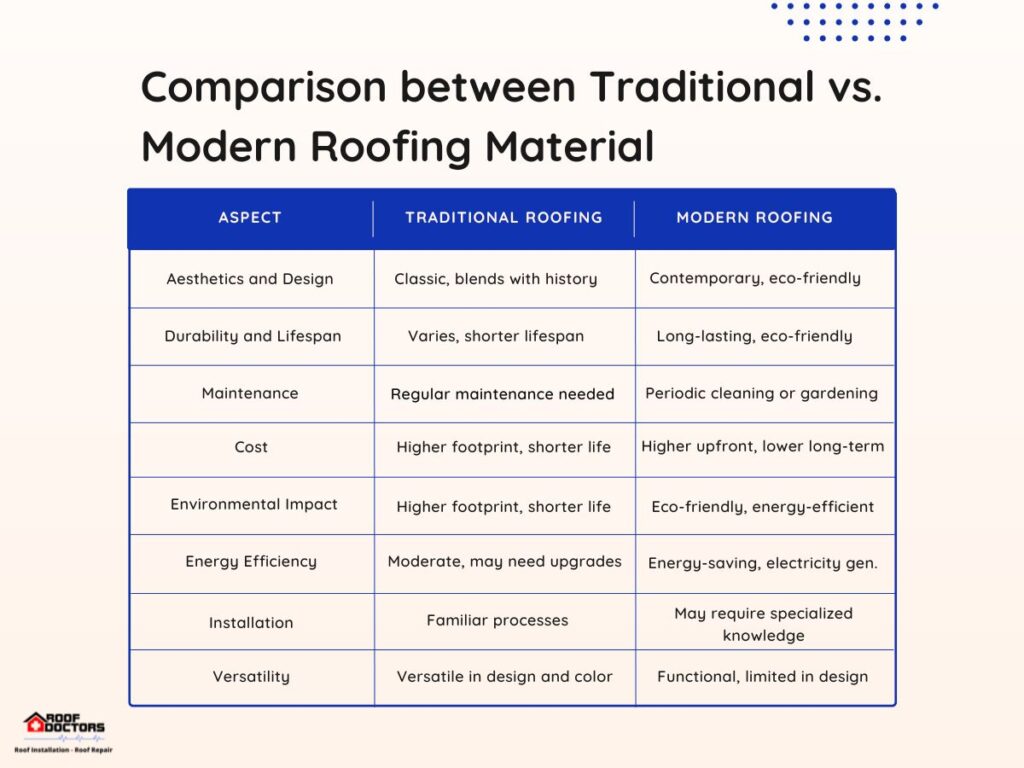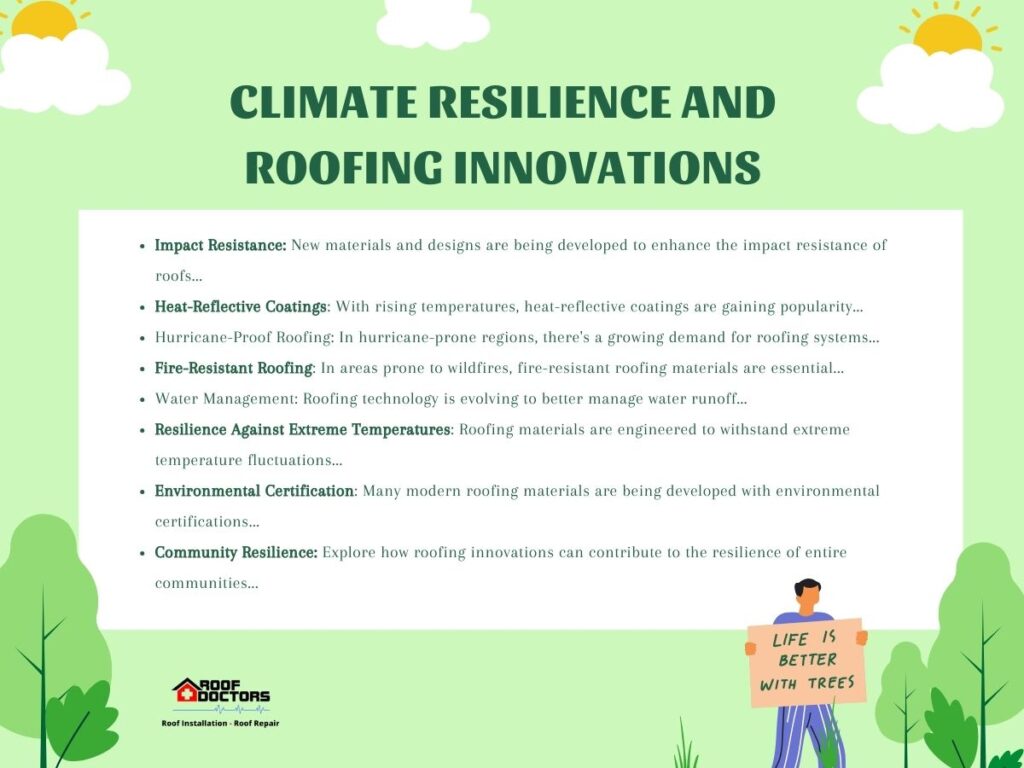What is the future of roofing? Roofing, often overlooked, plays a pivotal role in shaping our buildings and communities. It provides shelter and protection from the elements but also significantly impacts energy efficiency, aesthetics, and value.
As technology and architectural practices have evolved, so too have the materials and methods used in roofing. This post delves into the advancements in roofing technology and materials, highlighting the transition from traditional to modern solutions and the innovations driving the industry forward.
Traditional vs. Modern Roofing Materials
Roofing has evolved significantly, offering a rich array of options that cater to diverse needs and preferences. The choices are vast and varied, from the timeless appeal of traditional materials like asphalt shingles and wood shakes to modern, tech-savvy solutions such as solar panels and smart roofs.
Traditional Roofing Materials:
- Asphalt Shingles: A popular choice for many homeowners, asphalt shingles are cost-effective and easy to install. They come in various colors and styles, making them versatile for architectural designs. However, they have a shorter lifespan than other materials and can be susceptible to wind and hail damage.
- Wood Shakes: These offer a natural and rustic appearance. Made from split logs, wood shakes provide good insulation but require regular maintenance to prevent rot, mold, and insect infestation.
- Metal Roofing: Durable and long-lasting, metal roofs can withstand extreme weather conditions. They reflect sunlight, reducing heat absorption and helping in energy conservation. On the downside, they can be noisy during rain and hailstorms and might dent upon impact.
Modern Roofing Materials:
- Solar Panels: More than just a roof, solar panels generate electricity, reducing reliance on the grid and cutting down energy bills. They’re sustainable and can be integrated seamlessly with other roofing materials.
- Green Roofs: These living roofs are covered with vegetation, improving air quality and providing natural insulation. They also manage stormwater runoff and enhance the building’s aesthetics.
- Smart Roofs: Incorporating technology, such as smart roofs, can monitor weather conditions, control indoor temperatures, and even detect leaks or damages, ensuring timely repairs.
Comparison between Traditional vs. Modern Roofing Material
While traditional materials have stood the test of time, offering reliability and a classic look, modern materials prioritize sustainability, energy efficiency, and integration with technology. The choice often boils down to individual preferences, budget, and the building’s purpose.

Aesthetics and Design
- Traditional: Materials like asphalt shingles, wood shakes, and metal roofing offer a classic and timeless look. They can easily blend with various architectural styles, especially in historic or countryside settings.
- Modern: Modern materials like solar panels and green roofs provide a contemporary and sleek appearance. They’re often associated with cutting-edge design and eco-friendly buildings.
Durability and Lifespan
- Traditional: While materials like metal can last for decades, others like asphalt shingles and wood shakes have a shorter lifespan and might require more frequent replacement.
- Modern: Solar panels and smart roofs are designed for longevity, often outlasting traditional materials. Green roofs, with proper maintenance, can also have an extended lifespan.
Maintenance
- Traditional: Wood shakes require regular maintenance to prevent rot and insect infestation. Metal roofs, though durable, might need checks for corrosion or denting.
- Modern: Solar panels require periodic cleaning to maintain efficiency. Green roofs need gardening care, while smart roofs, with their sensors, can alert homeowners to potential issues, reducing unexpected maintenance.
Cost
- Traditional: Materials like asphalt shingles are cost-effective initially but might incur higher costs in the long run due to replacement and maintenance.
- Modern: While the upfront cost for solar panels or smart roofing systems might be higher, they can offer savings in the long run through energy efficiency and reduced maintenance.
Environmental Impact
- Traditional: Traditional materials, especially asphalt shingles, have a higher environmental footprint due to their manufacturing process and shorter lifespan.
- Modern: Solar panels reduce reliance on non-renewable energy sources. Green roofs improve air quality and reduce urban heat islands. Both contribute significantly to environmental conservation.
Energy Efficiency
- Traditional: While materials like metal reflect sunlight and offer some energy efficiency, they might need to match the capabilities of modern materials.
- Modern: Solar panels generate electricity, reducing energy bills. Smart roofs can optimize indoor temperatures, leading to energy savings.
Installation
- Traditional: Traditional roofing materials are widely used, and many contractors are familiar with their installation processes.
- Modern: Installing modern materials, especially solar panels, and smart roofs, might require specialized knowledge and expertise.
Versatility
- Traditional: Traditional materials are versatile in color, style, and design, especially asphalt shingles.
- Modern: Modern materials, especially solar panels, might have limitations in design versatility but make up for it in functionality and efficiency.
Advances in Roofing Technology
The roofing industry is not untouched by the technological revolution. Emerging technologies are reshaping how roofs are designed, installed, and maintained.
- 3D Printing: This technology allows for the rapid production of roofing components tailored to specific designs and dimensions. It reduces waste, ensures precision, and can even be used to create intricate patterns or designs.
- Nanotechnology: By manipulating materials at the molecular level, nanotechnology enhances the properties of roofing materials. For instance, it can make them more resistant to UV rays, improve their thermal performance, or increase their lifespan.
- Robotics: Robots are now used in roofing installations, especially for large commercial projects. They ensure accuracy, speed up the process, and reduce the risks associated with manual labor.
- IoT Sensors: Integrated into smart roofs, these sensors can monitor various parameters like temperature, humidity, and structural integrity. They can alert homeowners or building managers to potential issues, ensuring proactive maintenance.
- Drones: Drones are revolutionizing roof inspections. They can capture high-resolution images, access hard-to-reach areas, and provide detailed analyses of a roof’s condition without manual labor.
Smart Roofing Systems: The Future of Roofing
Smart roofing systems represent the next generation of solutions, integrating technology with traditional roofing materials.
Using sensors, these roofs can detect heat loss or gain areas, adjusting insulation or ventilation accordingly. They can also detect water accumulation or leaks, ensuring immediate waterproofing measures.
Combining data analytics and automation means that these roofs are not just reactive but proactive, anticipating issues before they become significant problems. These systems are characterized by:
- Sensors: Embedded within the roofing structure, they monitor temperature, humidity, and potential damage.
- Automation: Smart roofs can automatically adjust to weather conditions, optimizing energy consumption.
- Data Analytics: By analyzing data from sensors, smart roofs can predict potential issues, ensuring timely intervention.
- Optimizing Efficiency and Durability: Smart roofing systems are designed not only to protect but also to enhance the overall efficiency and durability of a building.
Climate Resilience and Roofing Innovations
Climate change is driving the need for more resilient roofing solutions. As extreme weather events become more common, roofing materials and technologies are evolving to better withstand these challenges.
Consider discussing the following points:

- Impact Resistance: New materials and designs are being developed to enhance the impact resistance of roofs against hail, falling debris, and high winds. Impact-resistant roofing can reduce the need for frequent repairs or replacements.
- Heat-Reflective Coatings: With rising temperatures, heat-reflective coatings are gaining popularity. These coatings can be applied to traditional roofing materials to reduce heat absorption, lower cooling costs, and contribute to urban heat island mitigation.
- Hurricane-Proof Roofing: In hurricane-prone regions, there’s a growing demand for roofing systems that can withstand the destructive forces of hurricanes and cyclones. These systems often include reinforced roofing materials and robust attachment methods.
- Fire-Resistant Roofing: In areas prone to wildfires, fire-resistant roofing materials are essential for protecting homes and buildings. Modern roofing materials are designed to resist ignition and slow the spread of flames.
- Water Management: Roofing technology is evolving to better manage water runoff. This includes improved gutter systems, drainage solutions, and designs that reduce the risk of water infiltration during heavy rains.
- Resilience Against Extreme Temperatures: Roofing materials are engineered to withstand extreme temperature fluctuations, which can cause expansion and contraction. This ensures that roofs maintain their integrity over time.
- Environmental Certification: Many modern roofing materials are being developed with environmental certifications and sustainability in mind.
- Community Resilience: Explore how roofing innovations can contribute to the resilience of entire communities. For example, shared solar roofs in neighborhoods can provide backup power during outages and contribute to grid stability.
Integration of Renewable Energy Sources
Roofing is becoming a key player in integrating renewable energy sources into buildings as the world shifts towards sustainable energy solutions. Roofing materials and technologies are evolving to accommodate renewable energy generation:
- Solar-Ready Roofing: Many roofing systems are now designed to be “solar-ready.” This means they are engineered to support the installation of solar panels or solar shingles, making it easier for homeowners and businesses to adopt solar energy.
- Solar Roofing Tiles: Solar roofing tiles, also known as solar shingles, are an example of seamless integration. These tiles mimic the appearance of traditional roofing materials while generating electricity from sunlight.
- Building-Integrated Photovoltaics (BIPV): BIPV systems are designed to blend with the architectural design of a building. They can be integrated into roofing materials, facades, or even windows, providing energy generation and weather protection.
- Energy Storage Integration: Roofing systems are increasingly being designed with the integration of energy storage solutions in mind. This allows excess energy generated by solar panels to be stored and used during peak demand or power outages.
- Wind Energy: Some innovative roofing designs incorporate small wind turbines or wind-capturing technologies to harness wind energy.
- Hybrid Systems: Explore how roofing systems are being developed to support a combination of renewable energy sources. For example, a roof might integrate both solar panels and small wind turbines to maximize energy generation.
- Efficiency and ROI: Provide insights into the efficiency gains and return on investment (ROI) associated with roofing-integrated renewable energy systems.
- Environmental Impact: Highlight the environmental benefits of roofing-integrated renewables, such as reduced greenhouse gas emissions and decreased reliance on fossil fuels.
- Government Incentives: Government incentives for roofing-integrated renewable energy systems often include tax credits and feed-in tariffs. These policies aim to stimulate adoption by providing financial benefits and promoting sustainable energy production, thus reducing reliance on traditional energy sources.
Conclusion
A remarkable blend of tradition and innovation marks the future of roofing. While traditional materials retain their timeless charm, modern roofing materials and technologies prioritize sustainability, energy efficiency, and integration with renewable energy sources. Moreover, advancements in roofing technology, such as smart roofs and climate-resilient designs, are shaping a more resilient and eco-conscious built environment. With government incentives supporting these innovations, the roofing industry is poised to play a pivotal role in creating greener, smarter, and more resilient communities.


